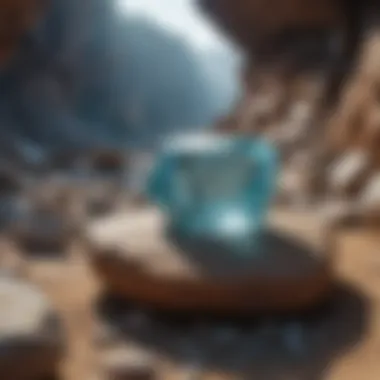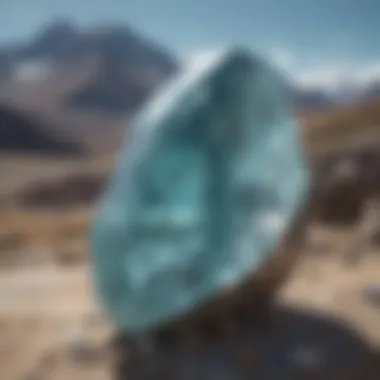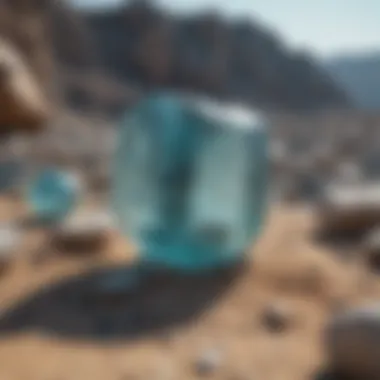Exploring the Global Origins of Aquamarine Stones


Rock and Fossil Identification
When it comes to identifying aquamarine stones in the wild, it is essential to understand the types of rocks and fossils associated with their formation. Aquamarine is typically found in pegmatite rocks, which are characterized by their coarse-grained texture and high mineral content. These rocks can often be identified by their light color and the presence of large crystals, which may contain aquamarine deposits. To assist in the identification process, collectors can utilize tools such as geology hammers, chisels, and magnifying glasses to examine the characteristics of rocks and fossils closely.
Collecting Tips and Techniques
For rock and fossil collectors seeking to unearth aquamarine treasures, it is imperative to follow best practices to ensure a successful and safe collecting experience. Locating prime collecting sites often involves researching geological maps and consulting with local experts familiar with aquamarine-rich regions. Once a suitable location is identified, collectors should exercise caution when extracting specimens to avoid damaging the delicate crystals. By employing tools like rock hammers and brushes, collectors can safely retrieve aquamarine stones without causing harm to the surrounding geological formations.
Preservation and Display
After successfully collecting aquamarine stones, it is crucial to preserve them using appropriate techniques to maintain their pristine condition. Preservation methods may include cleaning the stones using gentle brushes and water to remove any dirt or debris accumulated during the collection process. To store aquamarine specimens, collectors can utilize acid-free paper or storage cases to prevent discoloration and damage over time. When it comes to displaying these gems, creative ideas such as arranging them in shadow boxes or glass containers can showcase their natural beauty while protecting them from external elements.
Geological Insights
Delving into the geological insights surrounding aquamarine, enthusiasts can gain a deeper appreciation for the formation and historical significance of these captivating gemstones. Aquamarine is commonly found in pegmatite veins, which are created through the process of magmatic intrusions deep within the Earth's crust. Throughout history, aquamarine has been revered for its association with tranquility and clarity, making it a prized possession among gemstone collectors. Notable discoveries in the field include aquamarine crystals of exceptional clarity and size, providing valuable insight into the geological forces that shaped these stunning gems.
Introduction
Aquamarine is a mesmerizing gemstone that has captivated humans for centuries with its captivating blue hues. In this comprehensive guide, we delve into the enchanting world of aquamarine stones, exploring the diverse locations where these gems are unearthed. From the lush landscapes of South America to the rugged terrains of Africa and Asia, each region holds unique geological formations that give birth to these stunning blue treasures.
Overview of Aquamarine Stone
Aquamarine, a member of the beryl mineral family, is cherished for its ethereal blue shades that range from pale sky blues to deep cerulean tones. This gemstone is prized for its clarity and brilliance, with larger stones exhibiting exceptional transparency. Aquamarine derives its name from the Latin words 'aqua marina,' meaning 'sea water,' aptly describing its cool, calming color reminiscent of the ocean depths. The gem is treasured for both its beauty and metaphysical properties, believed to bring tranquility and harmony to the wearer.


Significance of Aquamarine in Gemology
In the realm of gemology, aquamarine holds a prominent position due to its unique optical characteristics and durability. Gemologists value aquamarine for its excellent clarity and vitreous luster, which enhances its allure. This gemstone's hardness, ranging from 7.5 to 8 on the Mohs scale, signifies its resilience against scratches and abrasions, making it ideal for jewelry that withstands daily wear.
Aquamarine's significance transcends its physical properties; it carries symbolic meanings as well. Revered as a talisman of courage and communication, aquamarine is believed to promote clear thinking and soothe heightened emotions. Its association with the element of water lends it a purifying and cleansing essence, fostering a sense of tranquility and balance.
South America
South America holds a significant position in the exploration of aquamarine stones globally. Known for its diverse geological landscape, the continent boasts several regions renowned for producing these captivating blue gemstones. The presence of aquamarine in South America showcases the rich mineral resources embedded within its terrain, drawing the attention of gemologists and collectors alike. The unique geological formations in South America contribute to the formation of high-quality aquamarine stones, making it a prime destination for sourcing these coveted gemstones.
Brazil
Minas Gerais Region
The Minas Gerais region in Brazil plays a pivotal role in the aquamarine industry. Renowned for its abundance of aquamarine deposits, this region stands out for its production of some of the finest quality stones. The unique geological composition of Minas Gerais fosters the creation of aquamarine crystals with exceptional clarity and color, making them highly desirable in the global market. Gemologists value the specimens from this region for their purity and brilliance, which set them apart from aquamarines found elsewhere.
Bahia Region
Another noteworthy area for aquamarine in Brazil is the Bahia region. The Bahia region offers a distinct variety of aquamarine characterized by a specific hue and tone that sets it apart from other sources. The aquamarines from Bahia exhibit a mesmerizing blend of blue hues, making them highly sought after by collectors and jewelry designers. The unique color profile of Bahia aquamarine adds a touch of exclusivity to each stone, elevating its value and appeal in the gemstone market.
Colombia
Colombia, although lesser known for aquamarine compared to Brazil, also holds significance in the gemstone industry. The country boasts aquamarine deposits that showcase varying characteristics compared to other regions. Colombian aquamarines are notable for their distinct color properties and inclusions, adding a touch of individuality to each stone. The unique geological environment in Colombia contributes to the formation of aquamarine specimens with specific features, making them a distinct choice for collectors seeking diversity in their gemstone collections.
Africa


Africa plays a significant role in the realm of aquamarine stones, boasting notable deposits that entice both collectors and researchers. The continent's mineral-rich lands nurture aquamarine formations, particularly in countries like Nigeria and Mozambique. African aquamarine stands out for its exceptional color and clarity, drawing interest from gem enthusiasts worldwide. The unique geological processes in Africa give rise to stunning aquamarine specimens sought after for their rarity and beauty. Nigeria, known for its diverse mineral wealth, showcases aquamarine of remarkable quality, with hues ranging from pale blue to deep azure, making it a coveted addition to gem collections. Furthermore, Mozambique's aquamarine mines yield gems prized for their transparency and brilliance, adding to the continent's allure in the gemstone industry.
Nigeria
Nigeria stands out as a prominent hub for aquamarine mining, with its gem-rich terrain harboring exquisite specimens highly regarded in the global market. The aquamarine from Nigeria displays a spectrum of shades, from delicate pastels to intense blues, captivating collectors with its vibrant hues. The gemstone's clarity and natural luster make Nigerian aquamarine a coveted choice for jewelry settings, complementing various designs with its elegance and sophistication. Mining operations in Nigeria meticulously extract aquamarine of superior quality, ensuring that each gem meets the stringent criteria for color, clarity, and carat weight. With a reputation for producing top-grade aquamarine, Nigeria solidifies its position as a prime destination for enthusiasts seeking exquisite gemstones of African origin.
Mozambique
Mozambique emerges as a key player in the aquamarine industry, renowned for its rich deposits of this captivating gemstone. Aquamarine mining in Mozambique unveils gems of exceptional brilliance and transparency, coveted for their distinct beauty and allure. The aquamarine from Mozambique boasts a clarity and color intensity that sets it apart in the global market, appealing to discerning collectors and jewelers alike. The gemstone's unique formations in Mozambique's geological landscape contribute to the creation of exquisite aquamarine specimens, each telling a story of the earth's intricate processes. With its reputation for producing premium aquamarine varieties, Mozambique continues to captivate enthusiasts with its exceptional gems.
Asia
Asia holds a crucial position in the global landscape of aquamarine deposits. With its vast expanse and diverse geology, the continent boasts several key locations renowned for producing these prized gemstones. From the karst landscapes of China to the mountainous terrains of Pakistan, Asia offers a rich tapestry of aquamarine sources. The significance of Asia in the realm of aquamarine mining cannot be understated, as it contributes significantly to the world's supply of this coveted gemstone. The geological processes and unique mineral formations in Asia give rise to aquamarine of exceptional quality and color, attracting the interest of gem enthusiasts and collectors worldwide.
Pakistan
Pakistan stands out as a prominent player in the aquamarine market, known for its high-quality gemstones sourced from the northern regions. The captivating blue hues and clarity of Pakistani aquamarine make it highly sought after in the gemstone industry. The country's mines, nestled amidst the rugged mountain landscapes, yield specimens cherished for their brilliance and transparency. The mining operations in Pakistan adhere to strict standards to ensure the extraction of top-grade aquamarine while preserving the natural beauty of the surrounding environment. With a rich history in gemstone mining, Pakistan continues to be a significant supplier of aquamarine to the global market.
China
China has emerged as a noteworthy destination for aquamarine enthusiasts, offering a unique blend of traditional mining practices and modern techniques. The gemstone deposits in various regions of China showcase a spectrum of aquamarine varieties, from pale blues to deep oceanic tones. The cultural significance of aquamarine in China adds an extra layer of allure to these gemstones, making them prized possessions for many. The mining industry in China places a strong emphasis on sustainable practices and ethical sourcing, ensuring that the process aligns with environmental and social responsibility. Exploring the aquamarine mines in China unveils a fascinating journey through history, geology, and craftsmanship, making it a compelling destination for gemstone connoisseurs.
Europe
Europe holds a significant place in the exploration of aquamarine stones globally. It is home to key regions that boast geological formations conducive to the formation of aquamarine. From the Ural Mountains in Russia to the rugged terrains of Spain, Europe offers a diverse range of environments where aquamarine can be found. The geological history of Europe contributes to the unique qualities of aquamarine unearthed from this continent, with each region showcasing distinct characteristics influenced by different tectonic activities and mineral compositions. The presence of aquamarine in Europe adds to the rich tapestry of gemstone diversity found across the continent.


Russia
The vast expanse of Russia harbors significant deposits of aquamarine, particularly in the Ural Mountains. The Ural Mountains are renowned for their aquamarine mines, which produce high-quality gemstones coveted for their clarity and color. The geological processes within the Ural Mountains have created ideal conditions for the formation of aquamarine, with crystals often exhibiting exceptional transparency and brilliance. Russian aquamarine is esteemed for its purity and intense blue hues, making it a sought-after gemstone in the international market. The mining industry in Russia plays a crucial role in extracting aquamarine responsibly while preserving the natural beauty of the region.
Spain
The gemstone-rich country of Spain also holds a prominent place in the realm of aquamarine mining. Spanish aquamarine is notable for its varying shades of blue, ranging from pale sky blue to deep oceanic hues. The regions of Galicia and Catalonia are known for their aquamarine deposits, with stones characterized by their striking clarity and size. The geological diversity of Spain contributes to the broad spectrum of aquamarine colors found within its borders, showcasing the natural artistry of these gemstones. Spanish aquamarine is favored for its unique color palette and is a popular choice among collectors and jewelers seeking distinctive gemstones for their creations.
Australia
Australia, a vast continent with diverse landscapes, plays a significant role in the global aquamarine market. The expansive territory of Australia holds various geological formations that give rise to unique aquamarine deposits, making it a sought-after location for gemstone enthusiasts and collectors alike. From the arid Outback to the lush coastal regions, Australia offers a wide range of environments where aquamarine can be discovered. The gemstone industry in Australia is well-developed, with sustainable mining practices in place to preserve the natural beauty of the land while extracting these precious stones. Mining companies in Australia adhere to strict regulations to ensure ethical sourcing and contribute to the country's economy. The rich history of aquamarine mining in Australia adds to its allure, with stories of remarkable discoveries and exceptional gemstone quality enriching the legacy of Australian aquamarine.
New South Wales
New South Wales stands out as a prominent region within Australia for aquamarine enthusiasts. The state's diverse geological makeup offers ideal conditions for the formation of stunning aquamarine crystals. With a combination of ancient rock formations and mineral-rich soils, New South Wales has been a consistent source of high-quality aquamarine gems for decades. The New England region, in particular, has gained renown for its aquamarine deposits, attracting gemstone enthusiasts from around the world. Mines in New South Wales employ advanced extraction techniques to uncover aquamarine crystals while prioritizing environmental sustainability and conservation practices. The aquamarine specimens found in New South Wales boast impressive clarity and color, making them highly coveted in the gemstone market. Collectors and geology enthusiasts are drawn to New South Wales for its diverse range of aquamarine varieties and the picturesque landscapes where these gems are unearthed.
Queensland
Queensland, another key player in Australia's aquamarine industry, offers a unique treasure trove of aquamarine deposits waiting to be explored. The state's varied terrain, including rugged coastlines and ancient rock formations, harbors hidden aquamarine gems of exceptional quality. Gem hunters and mineral collectors flock to Queensland in search of these prized blue gemstones, known for their distinctive hue and luminous appearance. The gem-cutting industry in Queensland thrives on the supply of locally sourced aquamarine, supporting local artisans and craftsmen in creating exquisite jewelry pieces. Sustainable mining practices and ethical sourcing initiatives ensure that Queensland's aquamarine industry remains environmentally conscious and socially responsible. With a wealth of aquamarine resources scattered throughout its landscape, Queensland continues to attract enthusiasts and experts alike who seek to unearth the beauty of these mesmerizing gemstones.
Conclusion
Aquamarine stone is not just a beautiful gemstone but also a reflection of the Earth's intricate geological processes. Understanding the significance of aquamarine locations worldwide is crucial for gemologists, rock enthusiasts, and collectors. From South America pulsating with vibrant aquamarine sources to the captivating terrains of Africa and Asia, each region contributes to the diversity and allure of these blue gemstones. Exploring aquamarine deposits unveils a world of wonder beneath the Earth's surface.
Final Thoughts on Aquamarine Stone Locations
The location of aquamarine stones significantly impacts their quality, color, and value. Countries like Brazil, known for its Minas Gerais and Bahia regions, offer a spectrum of aquamarine shades, from pale blues to deep azure. In Colombia, aquamarine mining adds to the gem's global popularity. Understanding the geological processes shaping aquamarine locations enhances appreciation for these natural marvels.
Exploring Aquamarine Deposits Worldwide
Aquamarine deposits worldwide showcase the planet's diverse mineral richness. Pakistan and China in Asia exhibit unique aquamarine formations, each with distinct characteristics. In Europe, Russia and Spain contribute to the global aquamarine market with their own geological wonders. Australia's New South Wales and Queensland regions add further richness to the aquamarine landscape. Delving into these deposits unravels a tapestry of colors and formations, highlighting the Earth's intricate gemological diversity.







